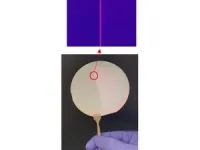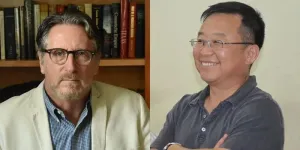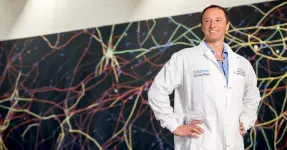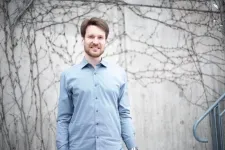(Press-News.org) UNIVERSITY PARK, Pa. — If a material absorbs light, it will heat up. That heat must go somewhere, and the ability to control where and how much heat is emitted can protect or even hide such devices as satellites. An international team of researchers, including those from Penn State, has developed a novel method for controlling this thermal emission, with what they called promising implications for thermal management and thermal camouflage technologies.
The team published their work on June 7 in the print edition of Science.
Led by researchers at The University of Manchester’s National Graphene Institute in England and the Penn State College of Engineering in the United States, with experts from Koc University in Turkey and Vienna University of Technology in Austria, the team demonstrated a way to build an interface that joins two surfaces with different geometric properties to localize thermal emissions from both surfaces, enabling a “perfect” thermal emitter. This means that the designed platform can emit thermal light from contained, designated emission areas with unit emissivity, or that the platform emits the strongest thermal radiation possible at that temperature.
“We have demonstrated a new class of thermal devices using concepts from topology — a branch of mathematics studying properties of geometric objects — and from non-Hermitian photonics, which is a flourishing area of research studying light and its interaction with matter in the presence of losses, optical gain and certain symmetries,” said corresponding author Coskun Kocabas, professor of 2D device materials at The University of Manchester.
The team said the work could advance thermal photonic applications to better generate, control and detect thermal emission. One application of this work could be in satellites, said co-author Sahin Ozdemir, professor of engineering science and mechanics at Penn State. Faced with significant exposure to heat and light, satellites equipped with the interface could emit the absorbed radiation with unit emissivity along a specifically designated area designed by researchers to be incredibly narrow and in whatever shape is deemed necessary.
Getting to this point, though, was not straightforward, according to Ozdemir. He explained part of the issue is limiting the perfect thermal absorber-emitter to the interface while the rest of the structures forming the platform remains “cold,” meaning those structures do not absorb or emit any form of energy.
“Building such a perfect absorber-emitter has been a major challenge,” Ozdemir said.
It is slightly easier to build an absorber-emitter at a desired frequency — as opposed to a perfect absorber-emitter that can absorb and emit any frequency — by trapping the light inside an optical cavity, the researchers said. The optical cavity comprises two mirrors, the first of which only partially reflects light, while the second completely reflects light. This setup enables what researchers call the “critical coupling condition,” where the incoming light partially reflected by the first mirror and the reflected light trapped between the two mirrors cancel each other out exactly. This completely suppresses the reflection, so the light beam becomes trapped in the system, getting perfectly absorbed and then emitted in the form of thermal radiation.
“We took a different approach in this work, though, by bridging two structures with different topologies, meaning they absorb and emit radiation differently,” Ozdemir said. “The structures are not at the critical coupling point, so they are not considered a perfect absorber-emitter — but their interface exhibits perfect absorption and emission.”
To achieve such an interface, the researchers developed a cavity stacked with a thick gold layer that perfectly reflects incoming light and a thin platinum layer that can partially reflect incoming light. The platinum layer, which comprises two separate thicknesses stitched together, also acts as a broadband thermal absorber-emitter. Between the two mirrors, the researchers placed a transparent dielectric, or material that insulates against electrical conductivity, called parylene-C.
The researchers can adjust the thickness of the platinum layer as needed to induce the critical coupling condition at the stitched interface and trap incoming light to be perfectly absorbed. They also can move the system away from the critical coupling to sub- or super-critical coupling, where perfect absorption and emission cannot take place.
“By finely tuning the thickness of the platinum layer to a critical thickness of about 2.3 nanometers, we bring the cavity to the critical coupling condition where the system exhibits perfect absorption and, as a result, perfect emission,” said first author M. Said Ergoktas, a research associate in materials engineering at The University of Manchester. “Only by stitching two platinum layers with thicknesses smaller and larger than the critical thickness over the same dielectric layer, can we create a topological interface of two cavities where perfect absorption and emission are confined. A crucial point here is that the cavities forming the interface are not at critical coupling condition, but that the interface itself is.”
The development challenges conventional understanding of thermal emission in the field, according to co-author Stefan Rotter, a researcher at the Vienna University of Technology in Austria.
“Every hot object radiates heat in the form of incoherent, random light,” Rotter said. “Traditionally, it has been believed that thermal radiation cannot have topological properties because of its incoherent nature.”
This work, however, demonstrated that thermal emission can be engineered to have topological characteristics, which can create strongly confined states of light that emit only from the topological interface between two surfaces. The researchers said they also can design the parameters of the interface to any shape, from a narrow line to something more complicated, like the outline of the United Kingdom.
According to Kocabas, their approach to building topological systems for controlling radiation is easily accessible to scientists and engineers.
“This can be as simple as creating a film divided into two regions with different thicknesses such that one side satisfies sub-critical coupling, and the other is in the super-critical coupling regime, dividing the system into two different topological classes,” Kocabas said.
The realized interface exhibits perfect thermal emissivity, which is protected by the reflection topology and “exhibits robustness against local perturbations and defects,” according to co-author Ali Kecebas, a postdoctoral scholar at Penn State. The team used experiments and numerical simulations to confirm the system’s topological features, as well as the non-Hermitian physics underpinning how the system works.
Contributors include Sina Soleymani, who earned a doctorate in engineering science and mechanics from Penn State in 2021 when the first phases of this work were completed; Konstantinos Despotelis, Gokhan Bakan and Alessandro Principi, University of Manchester; and Askin Kocabas, Koc University, Turkey.
The European Research Council, Consolidator Grant, the Air Force Office of Scientific Research Multidisciplinary University Research Initiative (MURI) Award on Programmable Systems with Non-Hermitian Quantum Dynamics and the Air Force Office of Scientific Research Award supported this work.
END
Researchers engineer new approach for controlling thermal emission
Finely created interfaces offer new design strategies beyond conventional materials for applications in infrared optics, sensing and more, researchers say
2024-06-10
ELSE PRESS RELEASES FROM THIS DATE:
UTA honors two faculty for distinguished scholarship
2024-06-10
The University of Texas at Arlington is honoring two faculty for their outstanding contributions to scholarship with the Distinguished Record of Research or Creativity Award.
Sam W. Haynes, professor of history, and Jaehoon Yu, professor of physics, are the 2024 recipients of the award, which recognizes faculty who have achieved a distinguished record of scholarship over an extended period.
“Jae and Sam have each been at UTA for more than 20 years, and they have each truly made an impact in the lives of the students we prepare for future careers,” said Kate C. Miller, vice president of research and innovation. "In addition, their contributions ...
New research describes the leisure motivations that underpin young U.S. adults' recreational cannabis use
2024-06-10
As of 2024, 24 states including Virginia and Maryland, and DC have legalized the adult recreational use of cannabis. As laws change, citizens' perceptions of the drug and reasons for using the drug have also shifted. In 2020, 34.5% of adults aged 18-25 reported using cannabis in the previous 12 months, according to the Substance Abuse and Mental Health Services Administration. Health experts seek to better understand the broader implications of legalizations and individuals’ motivations and attitudes related to cannabis use.
New ...
UC San Diego develops first-in-kind protocol for creating ‘wired miniature brains’
2024-06-10
Researchers worldwide can now create highly realistic brain cortical organoids — essentially miniature artificial brains with functioning neural networks — thanks to a proprietary protocol released this month by researchers at the University of California San Diego.
The new technique, published in Nature Protocols, paves the way for scientists to perform more advanced research regarding autism, schizophrenia and other neurological disorders in which the brain’s structure is usually typical, but electrical activity is altered. That’s according to Alysson Muotri, Ph.D., corresponding author and ...
Lone Star State: Tracking a low-mass star as it speeds across the Milky Way
2024-06-10
It may seem like the Sun is stationary while the planets in its orbit are moving, but the Sun is actually orbiting around the Milky Way galaxy at an impressive rate of about 220 kilometers per second — almost half a million miles per hour. As fast as that may seem, when a faint red star was discovered crossing the sky at a noticeably quick pace, scientists took notice.
Thanks to the efforts of a citizen science project called Backyard Worlds: Planet 9 and a team of astronomers from around the country, a rare hypervelocity ...
Researchers demonstrate the first chip-based 3D printer
2024-06-10
CAMBRIDGE, MA – Imagine a portable 3D printer you could hold in the palm of your hand. The tiny device could enable a user to rapidly create customized, low-cost objects on the go, like a fastener to repair a wobbly bicycle wheel or a component for a critical medical operation.
Researchers from MIT and the University of Texas at Austin took a major step toward making this idea a reality by demonstrating the first chip-based 3D printer. Their proof-of-concept device consists of a single, millimeter-scale photonic ...
Making remanufacturing profitable
2024-06-10
Returning end-of-life products to as-new condition is called remanufacturing and can be an essential element in a circular economy. But for more industrial companies to take an interest in it, remanufacturing needs to be economically viable. In a doctoral thesis from Linköping University, Johan Vogt Duberg has investigated how this can be accomplished.
“It’s possible to take advantage of increased environmental awareness to gain economic benefits. With remanufacturing, the costs of raw materials can be reduced, new customer groups found and ...
NSF awards additional $9.8 Million for Delta, DeltaAI
2024-06-10
The National Center for Supercomputing Applications was recently awarded $4.9 million of supplemental funding from the U.S. National Science Foundation (NSF) for Delta and an additional $4.9 million for DeltaAI to expand the potential capabilities of the soon-to-launch system by nearly 50 percent.
NCSA originally received nearly $25 million from NSF in 2023 to deploy and operate DeltaAI, an advanced computing and data resource that will be a companion system to Delta. DeltaAI will triple NCSA’s AI-focused computing capacity and ...
Breakthrough in creating cyclic peptide opens the way for new antibiotics
2024-06-10
A discovery made by scientists at King’s College London could speed up efforts to produce new antibiotics in the fight against antimicrobial resistance.
In a paper published in the Journal of the American Chemical Society, scientists from the Department of Chemistry share a new, rapid method for making cyclic peptides – an important class of antibiotic molecules. The approach takes minutes rather than the hours or days it normally takes, helping overcome a major challenge in antibiotic development.
Lead author Dr Sarah Barry, from the Department of Chemistry at King’s College London, ...
Unregulated sales of a toxic and hallucinogenic mushroom endanger public health
2024-06-10
Americans’ interest in a potentially harmful “magic mushroom” is soaring, with Google searches skyrocketing 114 percent from 2022 to 2023, according to a new study by researchers at the University of California San Diego Herbert Wertheim School of Public Health and Human Longevity Science. In a paper published in the American Journal of Preventive Medicine, the scientists suggest that the growing market for Amanita muscaria may be sparked in part by emerging clinical research supporting the safety and efficacy of psilocybin as a treatment ...
Alarming trends call for action to define the future role of food in nation’s health
2024-06-10
CHICAGO, June 10, 2024 — The cost of nutritious food and the lack of access to it are of significant concern to U.S. consumers. That’s according to a new national poll of public attitudes on food and nutrition conducted by Zogby Analytics on behalf of Research!America and the American Heart Association. Nearly 7 in 10 (68%) respondents recognize healthy eating habits as an important factor in improving a person’s chance for a long and healthy life. Yet more than half (53%) say the United ...
LAST 30 PRESS RELEASES:
Numbers in our sights affect how we perceive space
SIMJ announces global collaborative book project in commemoration of its 75th anniversary
Air pollution exposure and birth weight
Obstructive sleep apnea risk and mental health conditions among older adults
How talking slows eye movements behind the wheel
The Ceramic Society of Japan’s Oxoate Ceramics Research Association launches new international book project
Heart-brain connection: international study reveals the role of the vagus nerve in keeping the heart young
Researchers identify Rb1 as a predictive biomarker for a new therapeutic strategy in some breast cancers
Survey reveals ethical gaps slowing AI adoption in pediatric surgery
Stimulant ADHD medications work differently than thought
AI overestimates how smart people are, according to HSE economists
HSE researchers create genome-wide map of quadruplexes
Scientists boost cell "powerhouses" to burn more calories
Automatic label checking: The missing step in making reliable medical AI
Low daily alcohol intake linked to 50% heightened mouth cancer risk in India
American Meteorological Society announces Rick Spinrad as 2026 President-Elect
Biomass-based carbon capture spotlighted in newly released global climate webinar recording
Illuminating invisible nano pollutants: advanced bioimaging tracks the full journey of emerging nanoscale contaminants in living systems
How does age affect recovery from spinal cord injury?
Novel AI tool offers prognosis for patients with head and neck cancer
Fathers’ microplastic exposure tied to their children’s metabolic problems
Research validates laboratory model for studying high-grade serous ovarian cancer
SIR 2026 delivers transformative breakthroughs in minimally invasive medicine to improve patient care
Stem Cell Reports most downloaded papers of 2025 highlight the breadth and impact of stem cell research
Oxford-led study estimates NHS spends around 3% of its primary and secondary care budget on the health impacts of heat and cold in England
A researcher’s long quest leads to a smart composite breakthrough
Urban wild bees act as “microbial sensors” of city health.
New study finds where you live affects recovery after a hip fracture
Forecasting the impact of fully automated vehicle adoption on US road traffic injuries
Alcohol-related hospitalizations from 2016 to 2022
[Press-News.org] Researchers engineer new approach for controlling thermal emissionFinely created interfaces offer new design strategies beyond conventional materials for applications in infrared optics, sensing and more, researchers say





